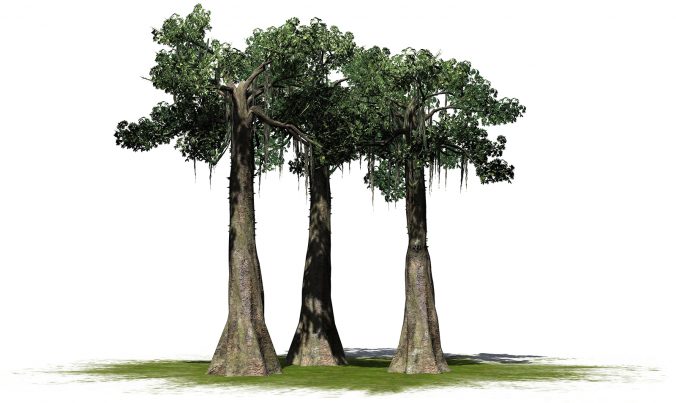The tallest tree on the African continent
I remember back in the last century when I was a kid sleeping on a kapok mattress. Put your hand up if you remember doing the same.
Of course, kapok filled mattresses are a product of the kapok tree (Ceiba pentandra). A tree that when mature is an impressive sight – the tallest tree on the African continent – soaring up to as high as a 20-story building, with a huge dense spreading canopy. Not surprisingly local inhabitants usually referred to kapok trees as “pillars that support the sky”.
When young the kapok tree trunk is bright green with groups of branches forming distinct horizontal layers, and with conical spikes erupting from the surface. The tree grows quickly, dropping its lower limbs and developing a stout grey trunk, spreading crown and impressive sweeping plank buttress roots that sink into the earth like gnarly folded boards. A large kapok tree is its own island of biodiversity with its giant branches supporting aerial plants and providing a home to countless species of insects and birds.
Kapok – a stout grey trunk, spreading crown and impressive buttress.
During long dry spells kapoks drop the leaves. Individual trees don’t flower and set fruit every year, but when they do, they do it with relish and before the leaves reappear there is nothing to distract pollinators. Every night during flowering each kapok tree producers ten litres of nectar making it worthwhile for bats to travel as far as 20 km between trees spreading pollen as they go.
The fruit that follows are pendulous boat shaped pods – hundreds on each tree – which ripen from green to leathery tan and contain perhaps 1000 seeds each. The seeds are handy for oil, but the main event is the kapok fibre: a mass of fine, silky hairs in which the seeds are cocooned. As the pods split, they look like thousands of cottonwool balls – the inspiration for other common name for the species: the silk-cotton tree.
The kapok tree was originally from tropical America, but from pollen evidence the kapok tree has also been growing in West Africa for at least 13,000 years.
Kapok fruit fibres are hollow micro-tubes with thin cell walls and a surface layer of wax, an arrangement that makes them exceedingly light and strongly water repellent. Until well after World War II kapok fibre was specified for filling lifejackets and lifebelts. Kapok fibre can absorb 40 times its weight in oil. This is an ideal attribute wherever oil needs to be separated from water, such as in the case of accidental spills.
When kapok fruit pods split, they look like thousands of cottonwool balls – the inspiration for other common name for the species: the silk-cotton tree.
The most famous and symbolically important kapok tree is surely the colossal landmark in the oldest part of Freetown, the capital of Sierra Leone. Former African slaves, who had gained their freedom by fighting for the British during the American War of Independence are thought to have given thanks by this sacred tree when they returned in the 1790s.
Kapoks have a strong association with well-being, both physical and mental. The Maya peoples used to refer to kapok trees as the “mother tree of humanity”. Today Sierra Leonians still pray and make offerings to their ancestors for peace and prosperity beneath these trees, that are revered throughout West Africa as the home of spirits. Because of their associations and their abundant shade kapoks are often used as meeting places, and also traditionally by local healers treating mental health issues in the community with what elsewhere be called group psychotherapy.
